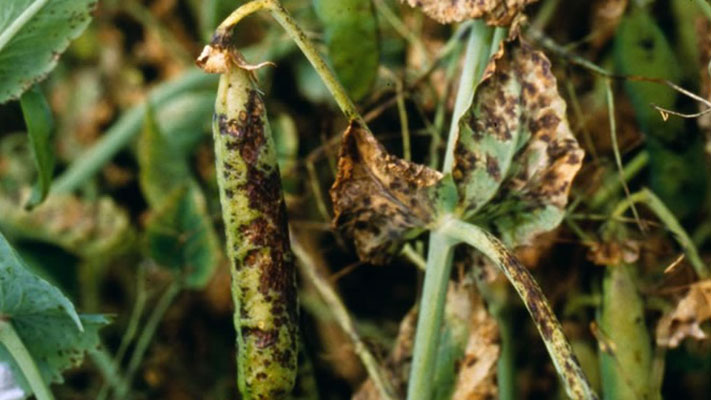Black Spot – Apples and Pears
Symptoms in pears and apples are very similar and therefore have been described as such unless otherwise indicated.
Refer to links below for more information on black spot in other crops.

Description
Apples are more susceptible to leaf infections than pears and symptoms appear as light green spots on upper or lower leaves, which turn brown, then black with raised blistered spots. Severe infections can produce distorted leaves and defoliation. Infected flower stalks develop black patches which extend, causing the flowers to shrivel and die.
Early fruit infection can cause distortion. Late infections on mature fruit appear as small spots which become darker as they grow and older lesions turn brown, dry looking and corky with cracks. While fruit growth is stunted and appears distorted, the lesions are superficial and the flesh is not affected. Fruit infected before harvest may not be noticed until later in storage, causing storage scab. Twig infections are common in pears, which appear as brown lesions before eventually forming into corky canker-like areas.
The fungus mainly survives as ascospores on infected leaves, twigs and bud scales from the previous season. Primary infection occurs when spores are released following rain and spread via wind onto trees. For infection to be successful, leaf moisture and ideal temperatures (12.8 – 23.9 °C) are required. Lesions from primary infections cause secondary infections by producing spores which further spread and infect other trees.
Control
Successful management of black spot in apples and pears relies on the use of several control practices. A post-harvest application with urea helps breakdown leaf material, in addition, the removal of infected leaves and fruit will reduce the risk of infection. Pruning to maintain an open canopy improves air flow, allows faster drying times and enables better coverage with fungicides.Control with fungicides aims to prevent primary infections early in the season, which subsequently reduces the likelihood of secondary infections. Post-harvest fungicide applications aim to prevent fungus surviving on leaves over winter.
Luna Sensation and Blue Shield are registered for control of black spot (scab) in apples and control of black spot (scab) in pears. Luna® Sensation and Blue Shield® should be applied early before disease symptoms appear.
References
Agriculture Victoria (2003), ‘ Apple Scab’, Agriculture Victoria, http://agriculture.vic.gov.au/agriculture/pests-diseases-and-weeds/plant-diseases/fruit-and-nuts/pome-fruit-diseases/apple-scabDepartment of Primary Industries (DPI) NSW (Viewed Oct 2019), ‘Apple and Pear Scab’, https://www.dpi.nsw.gov.au/agriculture/horticulture/pomes/pests-etc/apple-and-pear-scab
Hetherington, S and Munroe, A (2009), ‘Integrated pest management for Australian apples and pears – Apple Scab (Black Spot), Pear Scab’, The State of New South Wales, Industry and Investment NSW, Apple and Pear Limited pg 40 – 50, https://www.dpi.nsw.gov.au/__data/assets/pdf_file/0009/321201/ipm-for-australian-apples-and-pears-complete.pdf
McCarthy, A (2018), ‘Managing apple scab in Western Australia’, Department of Primary and Regional Industries (DPRID), https://www.agric.wa.gov.au/pome-fruit/managing-apple-scab-western-australia?page=0%2C2#smartpaging_toc_p2_s0_h2
Washington, W and Villalta, O (2006), ‘Pear Scab’, Agriculture Victoria, Note Number AG0159, http://agriculture.vic.gov.au/agriculture/pests-diseases-and-weeds/plant-diseases/fruit-and-nuts/pome-fruit-diseases/pear-scab







